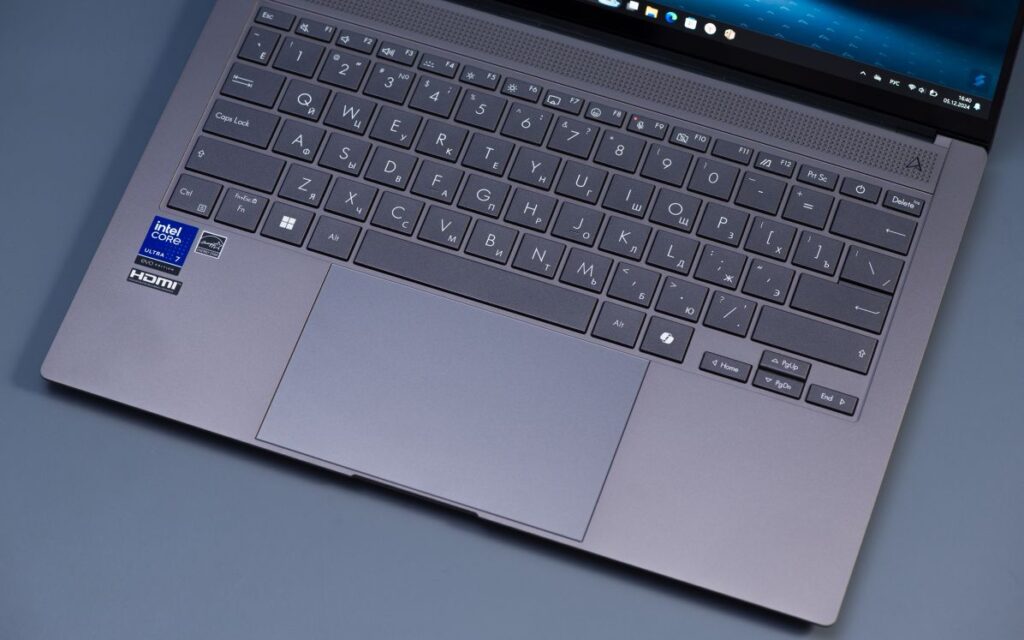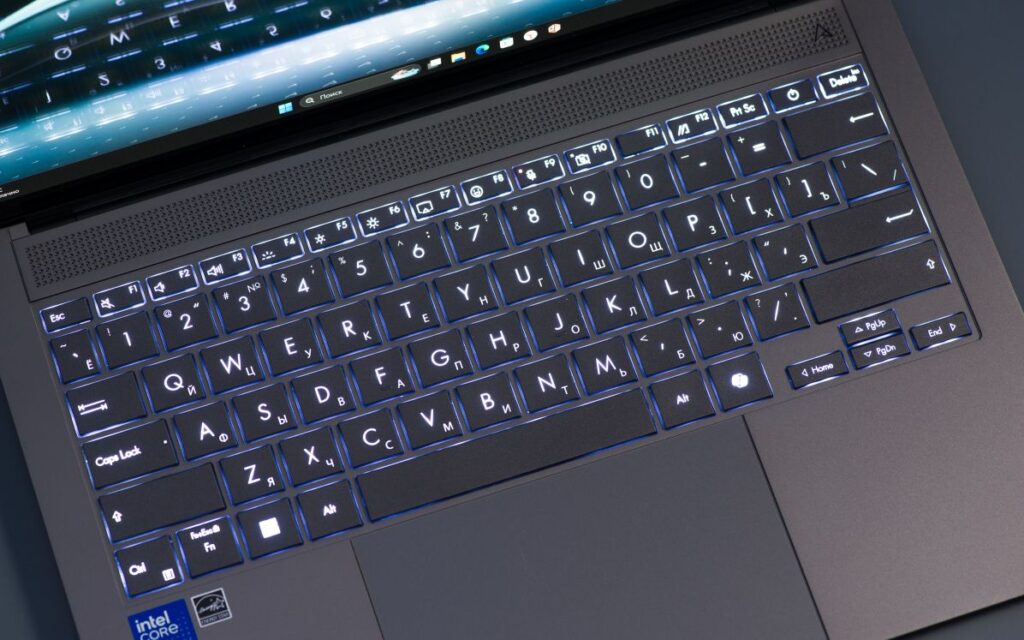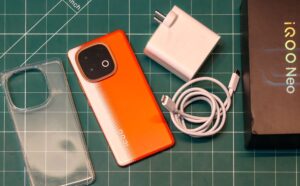That’s because you’re not yet familiar with the new ASUS Zenbook S 14. Choosing a laptop for work can be quite a hassle. After all, the device must be fast, lightweight, autonomous, and so on on a list of a dozen items. Sometimes it seems that there are no suitable devices — everyone is somehow different.

True Zen
Once upon a time, the creators of Zenbook turned to the philosophy of “Zen” – they used peaceful landscapes in promo, actively exploited the corresponding theme. The same principles are embodied in the ASUS Zenbook S 14 2024. Its design is minimalistic. The display cover received a “stone” texture, and not in the form of a sticker or relief paint, but by plasma deposition of aluminum oxide ceramics – Celaruminum. The coating is strong, wear-resistant and resistant to dirt.
And everything is done cunningly: from the outside, the branded “arrow” looks like a set of neat silver lines. Tactilely, the material resembles good expensive paper. But at the same time, it cools your fingers, like metal or stone. The top case and bottom are made of anodized aluminum, the tone is well chosen, perfectly combined with the outer cover.
It is difficult to find fault with the quality of workmanship – the lid is easy to open with one finger and is securely fixed in any position, the topcase does not play under the fingers during active printing, and the body of the device resists twisting. The MIL-STD 810H certification is not obtained for beautiful eyes – the laptop is not afraid of high and low temperatures, humidity, shocks and vibrations. It will not let you down at a crucial moment even in the most difficult conditions.
ASUS Zenbook S 14 Everything you need for work
Two key elements of a laptop’s ergonomics are the keyboard and the display. They are responsible for 90% of the user’s interaction with the device. As usual, we will talk about the screen separately, but we will discuss the keyboard here and now.

The Asus Zenbook S14 2024 has a short-stroke island keyboard. Keycaps are square, with sharp corners (very much in the spirit of Microsoft Surface of yesteryear), slightly rough. The backlight is bright white, uniform and clear. Despite the shortened key travel (1.1 mm against the classic 1.5), tactilely it does not look like an “apple butterfly” – it worked very dry, loud and with strong recoil, and the ASUS Zenbook S 14 keyboard manages to have a confident key travel and a very soft rebound at the same time.
There are questions only about the layout. The power button is dangerously adjacent to the Backspace and Delete keys – it sends the device to sleep even with a single press. You can change the response to the click in the Windows Control Panel, but when you pay a lot of money for a laptop, you want a product that doesn’t have such annoying little things.

The right Win/Menu button was replaced with Copilot, which is useless in the Russian Federation (this is one of the persistent ways to promote AI from Microsoft, now everyone will have it), and the right Ctrl is no longer there at all. But the rest is in complete order. The arrows are separated into a separate block, easy to feel blindly and confidently pressed, even despite the half-height.
There are no questions about his work – he is accurate and knows all the gestures of Windows with an A, and in addition, ASUS taught him a few more tricks. With one swipe, you can open the Screen Xpert settings menu, swipe your finger along the edge of the touchpad to control music volume, brightness level, video or audio rewind. We checked the work on YouTube, VK Video and Yandex.Music – everything is in order.
However, rewinding content only works if the window with the player is in focus. There is no tactile feedback from vibration motors, like HUAWEI or Apple, the return from the click is physical.

In terms of ports, the ASUS Zenbook S 14 2024 does not stand out from the competition. On the right is a fast USB Type-A, and on the left, there are two USB Type-C (Thunderbolt 4.0), HDMI and a combo audio output. The peripherals are connected to the peripherals, but users of a large number of devices will have to use a USB hub.
First-class screen and decent sound
The ASUS Zenbook S 14 2024 has a 14-inch OLED matrix. With a 16:10 aspect ratio and a 120Hz refresh rate, it’s easy to play and work on the screen. But the resolution is higher than usual – 2880×1800. This was done due to the peculiarities of the location of subpixels, since in OLED letters have fuzzy contours. High resolution allows you to overcome this ailment.

Separately, it is worth noting the struggle of ASUS Zenbook S 14 with another disadvantage of OLED – PWM. Windows does not normally adjust the brightness of such screens. Previously, ASUS Zenbook S 14 built a custom flicker-free DC dimming regulator into its software, and now it installs a matrix that initially has a low ripple coefficient of no more than 12% over the entire brightness range.
Also, the screen emits less harmful blue light (with a wavelength of <450 nm) and puts less strain on the eyes. This is confirmed by TUV Rhineland Low Blue light and SGS certificates.
The real one does not differ much, depending on the measurement method, the results range from 0.7 to 2.2 units. These are very decent indicators for factory calibration. It is almost impossible to make the color reproduction of an OLED screen better at home, even with all the necessary equipment.
The display fully covers DCI-P3 and AdobeRGB color spaces, and the maximum brightness reaches 600 nits. Quite enough to work with graphics in a well-lit room. The only thing that spoils this beautiful screen is the glossy surface. Bring back the matrix matrices!

The audio preparation of the ASUS Zenbook S 14 pleased. Only four speakers are installed, but they play great. Bass, mids and highs – you can hear everything. At the same time, the volume margin is decent, and there is no wheezing at the maximum level. With such equipment, you can organize a call, watch football, and play without headphones.
New Intel under the hood
The ASUS Zenbook S 14 2024 is available in three versions: with a junior Intel Core Ultra 5 226V + 16GB of RAM, Ultra 7 256V + 16GB and with an average Ultra 7,258V + 32GB in the hierarchy. These are processors based on the new Lunar Lake architecture. According to Intel, they have managed to reduce power consumption by 50% compared to the previous generation, which provides more than twice the performance per watt. So the new Lunar Lake is 20% more efficient than Qualcomm’s laptop chips.
What is the secret of such results? Lunar Lake is in many ways the first truly new architecture in many years, both in terms of core design and system-on-a-chip design.
The processor cores, graphics and some other components are in a common “Compute” unit, made using the 3 nm process, and the controllers and everything else are placed in a separate “Platform I/O” chip – it is manufactured using the 6 nm process. The once-great chipmaker Intel makes its new processors not in its own backward factories, but in TSMC’s advanced manufacturing.
But the main change in the global architecture is RAM. Now it’s not SoDIMMs, not a new CAMM, and not even a motherboard chip soldering. The memory chips became part of the processor and were mounted on the same substrate, so that data transmission delays were noticeably reduced, and memory power consumption dropped by 40%.
All-new CPU hardware
Instead of the previous generation P-cores, the novelty received new ones – without hyperthreading, but with high performance per watt. The manufacturer had the courage to abandon the technology that once made it a leader. According to Intel employees, due to the absence of blocks responsible for hyper-trending, 15% of the die area is saved and performance is increased by 5%. The scheduler has the same concept as in Meteor Lake: tasks run on efficient cores and are transferred to productive cores only when the economical part of the processor is 100% utilized.
The cache has been increased for the high-performance cores and the access of processor registers to memory has been improved, so that the cores are less “starved” waiting for data and consume electricity more efficiently. But the main thing is that the block for predicting code branches has been increased by eight times and the number of arithmetic operations performed per clock cycle has been increased.
Simply put, if P-cores waste energy, they don’t do it in vain, and if there is no work for them and the executable code is predictable and well paralleled, the task falls on the more modest E-cores. They slightly increased the block of extraordinary execution of instructions and improved the decoder – now the processor more fully loads E-cores with multithreaded calculations.
But they are still divided into high-performance (Lion Cove) and energy-efficient (Skymont). Now they are exactly in half – 4 by 4. In terms of IPC (the number of operations performed by a processor per clock cycle), fast cores are 14% ahead of their predecessors. The increase in productivity of slow ones is much more impressive – as much as 68%!
But this figure was achieved due to the fact that Intel chose for comparison the poorest cores from the last generation – those that stood on a substrate with a chipset. Not only were they cut off by power, but they also had noticeably higher memory subsystem latencies.
ASUS Zenbook S 14 Major AI and graphics improvements
Of the internal transformations, we note the work with cache memory of various levels, increasing its throughput, optimizing pipelines and engines, and improving various processor blocks. The control of voltages and frequencies of the cores was not ignored either – the controller is now with AI (artificial intelligence has even reached here), and the clock speeds change at intervals of 16.67 MHz instead of the classic 100 MHz.
The Thread Director has been improved once again. The neural block has also been upgraded — Intel claims to increase the “raw” performance of vector calculations by 12 times, and inferences (AI TOPS) — by four times. So the user now gets 48 TOPS only from the neuroblock. I just want to understand where to use such power…

The built-in received a new architecture – Arc Xe2 Battlemage. It is built on second-generation Xe units. For ease of understanding, this is an analogue of CUDA in NVIDIA graphics cards. In the younger models of processors, there are seven of them (index 130V), and in the older ones there are already eight (index 140V). Each block includes eight vector (XVE) and matrix (XMX) engines. Thanks to the presence of the latter, the AI performance reaches 67 TOPS (excluding NPU).
For gamers, the good news is that DirectX 12 Ultimate is fully supported. There is also hardware support for AV1 and VVC video encoding and decoding. The latter provides a 10% smaller size than the AV1. Adaptive resolution and 360-degree panoramic imaging can also be realized.
ASUS Zenbook S 14 Decent performance and gaming cooling
The very structure of the new processor says that this is not an architecture for performance records, the emphasis is on the energy efficiency of the CPU and decent results of the built-in GPU. Let’s see how this affected the results in benchmarks.
In Geekbench 6, it was possible to knock out only 2670 in single-core and 10959 in multi-core tests. For an objective picture, here are the results of other processors. As competitors, we chose the previous generation Intel to show the impact of the architecture changes, the current AMD Ryzen 9 AI 375HX, and the Qualcomm Snapdragon X Elite X1E-78-100 behind ARM.
| GeekBench 6 | Cinebench R23 | |
| Core Ultra 7 258V | single-threaded – 2670 multi-threaded – 10,959 |
single-threaded – 1829 multi-threaded – 9758 |
| Core Ultra 9 185H | single-threaded – 2434 multi-threaded – 12,841 |
single-threaded – 1864 multi-threaded – 16,002 |
| Ryzen 9 AI 375HX | single-threaded – 2799 multi-threaded – 15,126 |
single-threaded — 2019 multi-threaded — 23,518 |
| Snapdragon X1E-78-100 | single-threaded – 2430, multi-threaded – 14,397 |
single-threaded – 1063, multi-threaded – 9400 |
Compared to the previous generation, single-threaded performance has not sagged, which is pleasing. And multithreading naturally lags behind competitors with a large number of cores. The results in CineBench R24 are worth a special mention. If in the 23rd version of the benchmark, Intel piled on ARM, then in the optimized 24th, the situation is the opposite – ARM has 107/1106 points, while blue has 119/594. This is the role of optimization.
Benchmark results
| 3DMark Speed Way | 813 | 913 |
| 3DMark Steel Nomad Light | 3265 | 3225 |
| 3DMark Port Royal | 2133 | 2104 |
| 3DMark Time Spy | 4039 | 4305 |
| 3DMark Fire Strike Extreme | 4185 | 4165 |
| 3DMark Night Raid | 35 675 | 35 445 |
| 3DMark CPU |
Single-threaded 1144 Multi-threaded 5725 |
Single-threaded 1143 Multi-threaded 5703 |
| PCMark 10 Extended | 7169 | 6800 |
| — Essentials | 9679 | 9408 |
| — Productivity | 10 556 | 8846 |
| — Content Creation | 9559 | 9518 |
| — Gaming | 7310 | 7296 |
| GeekBench 6 |
Single-threaded 2670 multi-threaded |
Single Thread 2621 Multithreaded |
| Cinebench R23 |
single-threaded 1829 Multi-threaded 9758 |
single-threaded 1825 Multi-threaded 7829 |
| Cinebench R24 |
single-threaded 119 Multithreaded 594 |
Single-threaded 118 Multi-threaded 473 |
| CrystalDiskMark Linear |
Read 4998 MB/s Write 2963 MB/s |
Read 4998 MB/s Write 2707 MB/s |
| CrystalDiskMark Small Block |
Read 52 MB/s Write 115 MB/s |
Read 27 MB/s 62 MB/s recording |
Maximum power consumption does not exceed 37 watts, and performance is almost independent of the type of power supply – the results in benchmarks when powered from the outlet and from the battery can differ by only 10%. The available resources are enough to solve almost any task, and hardware codecs help when working with multimedia. Much more important is fast integration and long battery life. And with this, the laptop is fine.















